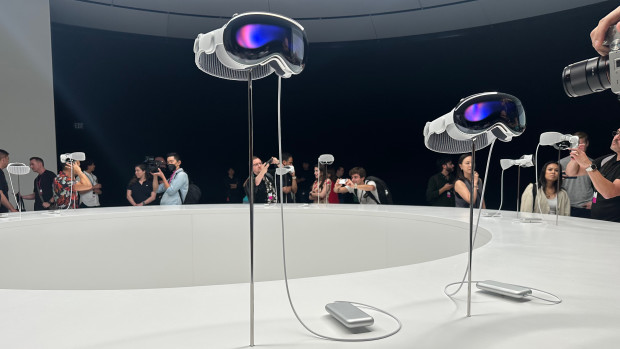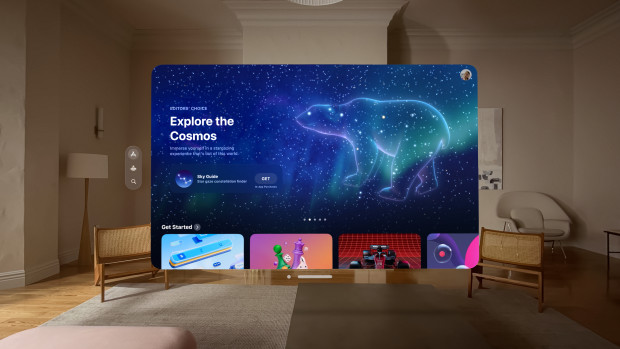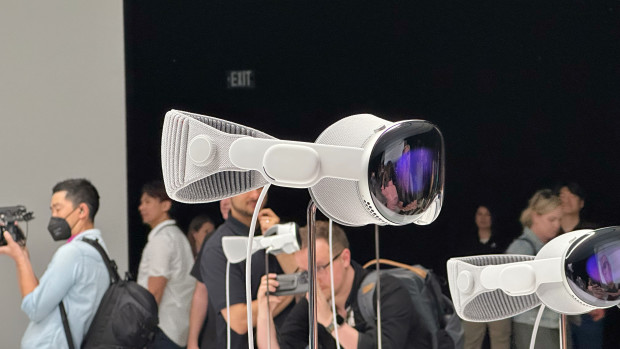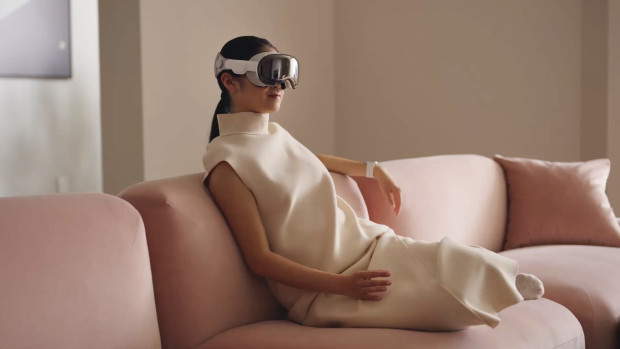No products in the cart.
Fitness Tips
I Tried the Apple Vision Pro Headset, and It's the Future
Men’s Journal aims to feature only the best products and services. We update when possible, but deals expire and prices can change. If you buy something via one of our links, we may earn a commission. Questions? Reach us at shop@mensjournal.com.
Towards the end of a long day at Apple Park, the technology giant’s campus in Cupertino, CA, I had a familiar yet entirely new experience. I took a quick minute meditation through Fitness+, but it wasn’t on an Apple Watch, an iPad, or iPhone.
It was a completely immersive experience on Apple’s just announced Vision Pro—what the company dubs a “spatial computer” and the “most advanced personal electronics device ever.” It’s a strong claim that fits with a similarly strong $3,499 starting price.
But after about 40 minutes of using Vision Pro, I have three words to describe it: remarkable, intuitive, and familiar. It achieves this thanks to a tremendous amount of hardware in new forms that took years of engineering work and an equally heavy lift with software. Inside, it features not one but two chips: M2, which Apple uses in the Mac and iPad, and a new R1 that handles real-time processing, which is critical for this experience. In total, Apple filed over 5,000 patents over the course of development here.
This all equals an immense amount of power in a device that screams futuristic goggles in a premium build and one that is akin to an augmented reality or virtual reality headset. However, if you’re thinking of Meta Quest, this is more premium in every conceivable way.
Apple isn’t shipping Vision Pro until early 2024, which gives them time to round out all the features and get developers onboard. Disney is a big name that will be joining, and, as you might suspect, all of Apple’s services will likely appear here.
It’s too early for a full review or even a real final thought on Vision Pro, but from what I saw, it’s one of the most compelling pieces of tech I have ever used. So let’s dive into that for a bit.
Getting Started With Vision Pro
Of course, before diving into VisionOS headfirst, I had to get set up with Vision Pro. The first step was a head scan via the True Depth camera on an iPhone for some sizing, and it’s akin to setting up Face ID. Then that same iPhone measured my ears for Spatial Audio in the same vein that you set up “Personalized Spatial Audio” with AirPods third-gen, AirPods Pro, or AirPods Max.
So very familiar, but next, as a glasses wearer, they had to measure my prescription and match me with Zeiss lenses that magnetically attach to the inside of the headset. Unlike the Meta Quest or PlayStation VR 2, Vision Pro cannot be worn with glasses. Thus, you need these specific lenses, which will likely cost extra. Apple quickly scanned my glasses for this demo and matched me with the proper lenses.
After that, I sat on a sofa and saw and touched Vision Pro up close. The build itself is ultra-premium, and unlike AirPods Max, it comes in one sleek shade that shows off the elements. It’s a mixture of aluminum, glass, and stainless steel with two customizable mesh bands or straps. One wraps around the rear of your skull and one on the top, both designed for fit.

Vision Pro resembles other virtual reality headsets, but Apple opted for a design that looks like an oversized pair of ski goggles. I pulled the back mesh band over my head and positioned the front to my face to wear it, and it was easy enough. To get the fit right, I used a dial on the back right side to tighten it, and a strap on the top of my head let me adjust the weight a bit. It’s supposed to sit comfortably between your forehead and your cheeks—it took about two adjustments for me, but then I was set.
Unlike a Mac, which you use a trackpad or mouse, and even unlike an iPad or iPhone, which you touch, Vision Pro uses gestures and your voice. I didn’t get to try the latter, but it will be a feature at launch. With the 12 cameras all around and a literal boatload of sensors, Vision Pro tracks your hands and an index finger tapping a thumb (or vice versa), which is how you click or confirm. Your pointer, or how you select and hover over something, is your eye. As wild as that sounds, Apple delivers something special here, but more on that in a few paragraphs.
There are two physical controls here, though, and if you have an Apple Watch or AirPods Max, you’ll be right at home. On the top right is the Digital Crown, which you can rotate either counterclockwise or clockwise to exact an environment—a mode that takes you out of the space you’re in—or back to the passthrough, which shows your room. You can also push in the Digital Crown to go home. There is also another rectangular button for other commands.
This all comes together for controls of Vision Pro, and the screen is basically wherever you are, as you can place app windows over your environment, even a FaceTime call, or you can enter these digital environments that transport you somewhere without actually moving. The latter is Apple’s VR take, but with some special tricks.
First, you can rotate the digital crown to quickly move back to the real world and shrink down the digital environment. Secondly, if you’re speaking with someone and look at them, they’ll appear within the environment with tremendous clarity. It’s really wild.
The screen here is easily one of Apple’s best and really the best of any headset I’ve used. Each eye gets a 4K display with super tiny pixels and it packs a massive punch in terms of details.
That is plenty immersive, but doubling down in that aspect is Spatial Audio speakers. And Apple says this is their most advanced setup with Spatial Audio and you have a dedicated speaker for each ear. It was impressive, but it’s not noise canceling like AirPods Pro or AirPods Max. Though, you can use AirPods Pro with Vision Pro.
Journey Into VisionOS

With all the hardware and two processors inside Vision Pro, it’s important to know it’s a standalone computer running VisionOS. Unlike an Apple Watch, this doesn’t need to be tethered to another device like an iPhone. Still, it’s deeply ingrained into the Apple ecosystem.
Once powered up, I saw a cursive “Hello” went across the screen and then ran through a quick eye tracking setup—and I’ll say it, the eye tracking capabilities here are spot on. For the setup, much like on a Meta Quest Pro or Quest 2, you follow circles that glow around with just your eyes. Vision Pro learns the movement and adapts to it. This setup is also super simple and quite seamless.
From there, I was in VisionOS, and the Home Screen is a few rows of apps that look like the app view on the Apple Watch. As I glanced from icon to icon, they’d grow in size a bit and almost have a spotlight on them. It was very accurate, even as I quickly glanced back and forth between them.
The whole navigation with my eyes felt very natural and incredibly swift. It didn’t stutter much, even for a not final unit. And this interface was laid on top of the space I was in. I could still make out the room very clearly thanks to an excellent passthrough mode close to what I saw moments before putting the headset on. I could make out the other folks and artwork on the wall and even see my Apple Watch’s screen.
What I saw was captured from the high-quality cameras baked into Vision Pro and processed in real-time. I didn’t notice any latency or weird color skewing as I had experienced with other pass-throughs on VR headsets. I was viewing it through an incredible set of displays that placed the home screen directly in front of me, in front of the space I was in. So, when I opened Photos, that windowed app appeared with that same backdrop, which was basically a live view of the room. So I’m wearing a headset, which is inherently a personal experience but not separated from the space around me in this mode.
To open that app, I looked at the Photos icon and then tapped my thumb and index finger together. It didn’t matter where my hand was either—it could be in front, off to the side, or even way lower, as Vision Pro can see a full 180 degrees to capture the action. That’s thanks to hand tracking and given the level of use that Apple’s delivered here, it eliminates the need for controllers entirely.
Once I opened the Photos app, I could glance around at the library and see the spotlighted images. I selected one that I wanted to look at in more detail, did the hand gesture and it opened up, I could then immerse myself in further and make it full screen. Here with a portrait or landscape shot, the two displays flex to offer vibrant colors along with stark contrast.
What really blew me away was viewing a panoramic shot captured from an iPhone as it stretches all around in fullscreen mode. Truthfully, really neat and almost hard to put into words. Since Photos on VisionOS is similar to Photos on iOS, iPadOS, macOS, or even watchOS, any Apple user will get a sense of familiarity here.
The overall level of detail and clarity is unlike other headsets I’ve used. Take Safari, for example. When looking at a webpage with text, the result is sharp, crisp inky blacks that I can make out clearly and didn’t feel like I was straining my eyes over. I can also easily scroll by pinching my index finger and thumb and sliding it across. It’s akin to pulling a string and fairly easy to get the hang of. This is also how I swiped between photos, but you can also pinch and move around to place a window somewhere else.
In fact, I left Photos on the ceiling for almost the entire demo and Vision Pro just ensured it stayed in that parking spot. You can even layer windows of specific apps on top of each other, akin to the Mac.
If you work with multiple displays like me, it’s like the ultimate canvas, as there is almost endless potential to place apps and windows. You can also use messages, notes, and various other Apple apps. There is also a ton of potential here, but I didn’t walk away knowing if this is destined to up productivity per se. It really depends on what developers do and similar to the iPad or iPhone, Apple is hoping we’ll get some killer apps to maybe walk away with.
It’s also worth noting that iOS, iPadOS, and macOS developers can easily port those apps over to VisionOS. When the Vision Pro launches in 2024, there will be an App Store as well.
Seriously Immersive Visuals Coupled With Spatial Audio

One of the other impressive aspects of my time with Vision Pro would be taking in films and content. I navigated to the Apple TV app to watch Avatar in 3D and the headset is kind of perfect for this. As there is a certain amount of spatial awareness and depth as the creatures move in and out. I can watch it just as a window in my space or I can opt for a personal theater mode that transports me into a lights-out theater with the screen front and center. It’s quite neat and if you’re someone who watches content alone, it ups the immersion. The Spatial Audio speakers here did an excellent job of properly placing sound around as well.
Then there is a new type of content that Apple let me experience called “Apple Immersive Video” which is shot in 180-degree FOV to let you go somewhere without actually going. A little more out of the world, and likely a demo to show the potential, was “Encounter Dinosaurs,” and one that I stood up and walked around for. It began with a portal opening to a prehistoric time and a butterfly that flew out of it and into my space. I stuck my finger out and the butterfly landed on it, and was able to bring it closer without any graphical mishaps. All of this is happening in real-time on Vision Pro. Once I stood up, I decided to venture closer to a T-rex in my space that I could see as a 3D figure.
While I couldn’t capture video or photos of myself using Vision Pro, or even see the “EyeSight” mode in which the forward-facing screen reveals your eyes or a view of your eyes, I did get to try a FaceTime call with an Apple rep who was using there own Vision Pro in another space.
The Persona they created aren’t cartoonish like we’ve seen from other headsets, but very very life-like. And the fact that you can scan yourself with the headset while it’s off, is pretty impressive that it can handle that modeling. I’ll also say Vision Pro handled that FaceTime call and a shared Freeform experience without any lag.
Thus far, these are just some of the demos I experienced in this brief hands-on and my first time, just hours after the unveiling or trying out Vision Pro. The one that stuck out to me the most, a full 16 or so hours later, was the Mindfulness Meditation, which encapsulates what an experience is like here. It starts like a quick meditation that you can fire up on an Apple Watch with some graphics, but as the class progresses, so do the animations, which immerse you completely. That together with the instruction, in this case, led by Jessica Skye, created a compelling experience.
Final First Thoughts on Apple’s Vision Pro

After just a half hour or so with Vision Pro, this is my first impression, not a full review. It is clear, though, that Apple really did it and is offering a mixed reality experience with excellent eye and hand tracking, a simple and intuitive interface with enough power, and a high degree of immersion. They got a lot right at least from this experience with generation one.
Still, the large elephant in the room is price and what the final experience will be at launch. I’m walking away impressed right now, that’s for sure, and eager to head back into VisionOS, but we need to learn more about it and the experiences before this is for everyone. After all, Apple will need to convince folks to wear a computer on their face and for the price.
Prices are accurate and items in stock at time of publishing.
Source link

